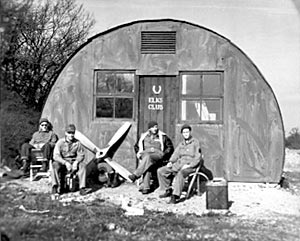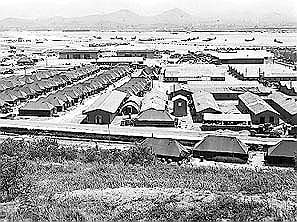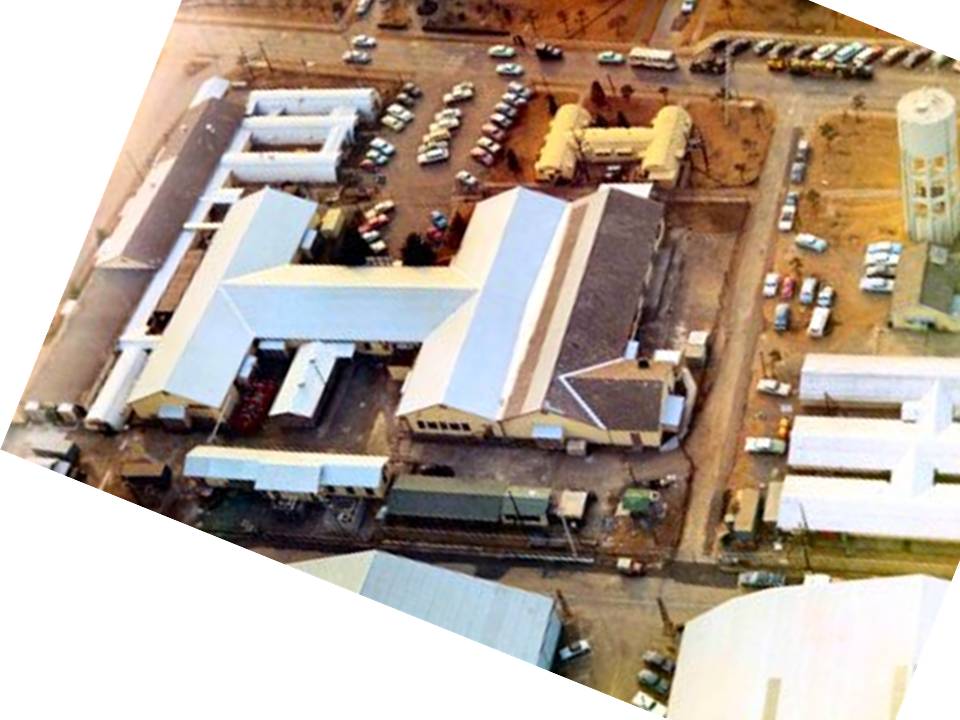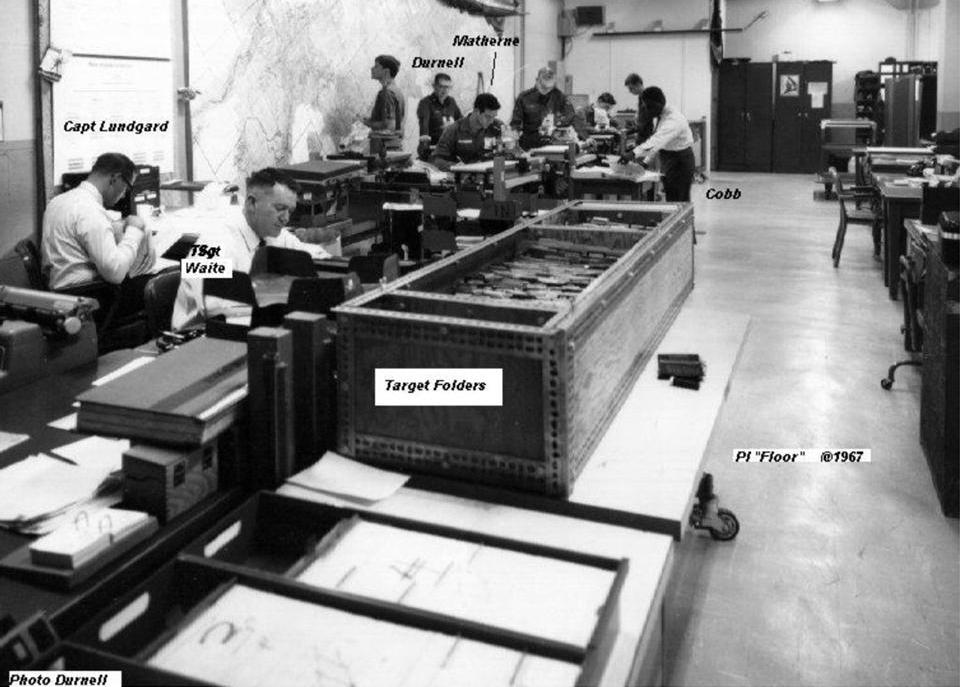

Turris Fortitudinis (Pillar of Strength)
Pro Deo Et Patria (For God and Country)
The 67th Reconnaissance Technical Squadron (RTS) began as the 67th Observation Group (OG) at Esler Field, Louisiana on September 1st, 1941. Although the 67th had primarily a visual observation mission, each squadron had a few technicians to maintain cameras and process the imagery. In September 1942, the unit deployed to England. In May 1943, the unit was renamed the 67th Reconnaissance Group (RG) and in November 1943 the 67th Tactical Reconnaissance Group (TRG). In Europe, the unit flew A-20, P-51, F-4 (photo versions of the P-38) and a few Spitfire aircraft. At that time all photo interpretation was done on prints verses the later dupe positives on a light tables. The 67 TRG was eventually equipped with trailer and tent housed mobile photo centers. Units of the 67th deployed to France within a month after D-Day and moved forward with the allied advance across Europe. The unit was de-activated on November 9th, 1945.

Enlisted troops of the 67th Observation Group in front of the Elks (enlisted) Club at Membury AB, England in the Fall of 1942
In May 1947, a new 67 TRG was organized under the Tactical Air Command at March Air Force Base, California. Six months later it was designated as a Tactical Reconnaissance Wing (TRW). The unit flew F-6 (RF-51), RB-26 and RF-80 aircraft. In June 1948, it reverted back to a TRG, then back to a Recce Wing in August 1948, only to be deactivated due to budget cuts in March 1949. Much of its equipment and personnel from the 67th were transferred to the 363rd RTS at Langley AFB, Virginia. (WW-II and post-war history derived from the book ‘Asia From Above’ by Roy M. Stanley, II)
The USAF Asia reconnaissance intelligence processing, exploitation, and mapping facility (Bldg 206) at Yokota AB, Japan began business in 1946 as the 6th Photo Technical Sq.
On June 25th, 1950 the communist Democratic People’s Republic of Korea (DPRK) invaded the Republic of Korea (ROK), at that time there was one “Recce Tech” in the Far East Air Force (FEAF), the 548th RTS stationed at Yokota Air Base (AB), Japan. In August 1950, the 363 RTS moved from Langley AFB, Virginia, to Itazuke AB, Japan to provide additional imagery support to the FEAF. To fill the void resulting from the move of the 363 RTS to Japan, the 67 RTS was activated at Langley AFB with skeleton manning. In October 1950, the 363 RTS moved to a school building in downtown Taegu, ROK. After a fire in the photo lab destroyed much of it’s equipment and film, the 363rd moved onto K-2 (Taegu) AB.
On February 25, 1951, the 67 TRW) was formed at Itazuke AB, On March 21st, the 67 TRW moved to K-2 and the 363 RTS at K-2 was re-designated the 67 RTS, with the 363 RTS designation moving back to Langley. In August 1951, the 67 RTS moved to K-14 (Kimpo) AB, west of the ROK capital of Seoul. In Korea, the 67th processed and exploited imagery flown by the RB-26 Invader, RF-80 Shooting Star, RF-86 Sabre Jet, and the RF-51 Mustang. On July 27, 1953 the truce was signed at Panmunjon. In late 1954, the 67 RTS moved to Itami AB (Now the terminal area of the Osaka International Airport), Japan, and on July 1, 1957 it moved to Yokota AB where it replaced the 548 RTS. (Korean War history of the 67 RTS based on the book ‘ Photographic Aerial Reconnaissance and Interpretation, Korea, 1950-1952’, Ben Hardy and Duane Hall)

67th RTS Compound at K-14 (Kimpo AB), ROK
After distinguished combat service in the Korean War, the 67 TRW moved to Yokota in July 1957 and was inactivated December 1960. The Recce Tech Squadron absorbed the cartographic personnel and functions of the deactivated 548 RTS and remained active to monitor the Korean DMZ and peripheral reconnaissance of Communist Asia as well as other intelligence imagery tasks. In December 1960, war in Southeast Asia launched the 67th towards greatness.

67 RTS Building 206 at Yokota Air Base, Japan
As the only functioning “Recce Tech” west of California, tasking and incoming imagery multiplied and so did innovation to help the steadily declining manning accomplish the growing workload on a timely basis. The importance of the 67th was shown by an operating budget of $3 million and assets worth over $4.5 million/ including several “one of a kind” machines in the Photo Lab.
It was also one of the first Air Force intelligence units to experiment with data automation, developing: an Integrated Data Base that became the Pacific standard; a man/machine readable PI reporting format that was used Worldwide; a Route Search system to aid PIs to wade through increasing volumes of information; and a system to allow PIs on-line access to intelligence and reporting tools.

Capt Roy Cottrell with the IBM 1401 Computer
67 RTS Intelligence Data Handling System (IDHS)
On one occasion, with three back-to-back high priority missions, the Photo Lab processed 4,200 feet of Original Negative and distributed 83,500 feet of Duplicate Positive in 17 hours. Using that imagery, 24 PIs had an Initial Report out in three hours, satisfying national requirements, and eventually wrote 34 reports from ONE mission with 7,000 targets researched, completely updating data on a denied nation. SmogCount, regular CNAF missions, Sharpcut, Tired Girl and Tassel Girl, Church Door, Giant Dragon, Bumpy Action, Commando Clinch, Look and Clasp, Food Fair and Wild Rice, Black Shield and Giant Scale, we handled them all, and, for a decade, were the ONLY RTS trusted with initial work on some of these missions.

67RTS PI Floor
With three Outstanding Unit Awards, the 67th at Yokota AB was consistently cited for “outstanding achievement excelling in the production of photographic, intelligence and computer products materially contributing to the support of combat operations in SEA and the satisfaction of national and theater intelligence requirements. “With such fantastic reputation for success, innovation and timely response to every challenge, it is clear why the 67th of those years was widely recognized in Washington, D.C, Southeast Asia, Hawaii and Korea, and in many of our memories, as the BEST OF ITS KIND!
(The 67 RTS, Yokota AB, history provided by Roy M. Stanley, II, author of ‘Asia From Above’)
In September 1970, it was announced that the 67th RTS would be deactivated as part of a reduction in forces in Japan and the missions and many of the personnel would be moved to the 548 RTG in Hawaii. There were other reasons besides the reduction in force for the closure of the 67th, mainly command decisions made in Hawaii and at the National level. By the spring of 1971, building 206 on Yokota had been cleared out and the last of the 67th personnel departed for either Hawaii or other assignments.
During the Vietnam War, the 67th TRW was re-activated at Mountain Home AFB, Idaho. In July 1971, the 67 TRW moved to Bergstrom AFB, Texas and on July 15th 1971 the 67 RTS was re-activated as part of the 67 TRW. On September 1, 1977, the 67 TRW was deactivated, only to resurface as the 67th Intelligence Wing at Kelly AFB, Texas on October 1, 1993. In August 2000, the wing was designated the 67th Information Operations Wing, then on July 5th, 2006, the wing was again re-designated as the 67th Network Warfare Wing at the Kelly Field Annex of Lackland AFB, and in 2014 the unit was again re-designated as the 67th Cyberspace Wing. Despite having a SIGINT mission, a squadron of the 67th Intelligence Wing was given the 67 RTS history and awards as part of their lineage and heritage. (Post Yokota history based on ‘Asia From Above’ and Wikipedia history of the 67th Network Warfare Wing)

67th Cyberspace Wing
(Lux Ex Tenebris, the light from the darkness)
The 67th Reconnaissance Technical Squadron honors include a campaign streamer from World War II in the European-African-Middle Eastern Theater, a streamer from the Korea War, six Air Force Outstanding Unit Awards (AFOUA) and the Republic of Korea Presidential Unit Citation.

World War II European-African-Middle Eastern Theater
Rhineland 1944-1945
Central Europe 1945


Korean War
First UN Counteroffensive 1951
CCF Spring Offensive 1951
UN Summer-Fall Offensive 1951
Second Korean Winter 1951-1952
Korea, Summer-Fall 1952
Third Korean Winter 1952-1953
Korea, Summer 1953


Air Force Outstanding Unit Award
December 1, 1952 – April 30, 1953 Kimpo AB, Korea
February 1, 1964 – January 31, 1966 Yokota AB, Japan
June 1, 1967 – May 31, 1968 Yokota AB, Japan
June 1, 1968 – May 31, 1970 Yokota AB, Japan
July 15, 1971 – May 15, 1973 Bergstrom AFB, Texas
May 16, 1974 – May 15, 1975 Bergstrom AFB, Texas
Republic of Korea Presidential Unit Citation

February 10, 1951 – March 31, 1953
67 RTS Commanders in Korea:
LtCol Joseph F. Condon Mar 1951 – Sep 1951
LtCol Schuyler S. Harris Sep 1951 – 1953
LtCol William W. Robinson 1953 – 1954
67 RTS Itami Air Base Commanders:
LtCol William W. Robinson 1954-1955
Maj DeMay H. White 1955-1956
LtCol Robert Spencer July 1956 -?
67 RTS Yokota Air Base Commanders:
Lt. Col. Daniel T. George 1958 – 1961
Lt. Col. / Col. Wesley F Wallace 1961 – 9/1962
MAJ. Lewis E. Watson 9/1962 – 11/1962
Lt. Col. John R. Paulman 11/1962 – 11/1964
Lt. Col. Lawrence U. Gray 12/1964 – 10/1967
Lt. Col. William Echert 10/1967 – 11/1967
Lt. Col. Alfred M. Kamajian 11/1967 – 11/1968
Maj. Marvin Richman 11/1968 – 5/1969
Lt. Col. Michael Mitchell 5/1969 – 5/1971